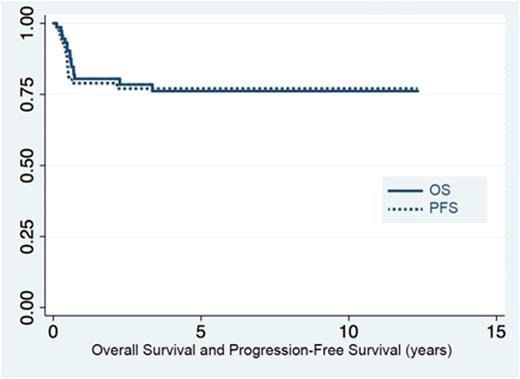Abstract
Background: Burkitt lymphoma (BL) is a highly aggressive non-Hodgkin lymphoma associated with translocations involving the c-MYC oncogene on chromosome 8. The 1996 Magrath regimen, CODOX-M/IVAC, showed a promising 2-year (y) event free survival (EFS) of 92% in 41 BL patients (pts), with additional trials of a dose-modified regimen demonstrating 2y overall survival (OS) 70-82% and 2y progression-free survival (PFS) 64% (Mead et al). A recent trial demonstrated that with addition of R, 3y OS and EFS were 83% and 75% (Ribrag et al). We sought to determine survival outcomes of adult BL pts in BC treated with CODOX-M/IVAC +/- R to evaluate the effectiveness of this regimen on a population basis.
Methods: All pts >=18 years of age diagnosed with BL from Jan. 1, 2001-Dec. 31, 2015 and initiated on CODOX-M/IVAC +/- R were identified through the Leukemia/BMT Program of BC database and cross-compared with the BC Cancer Agency Lymphoid Cancer clinical and pathology databases. The risk-adapted Magrath protocol has been standard of care in BC since 2001, with R added as of 2004. Bone marrow transplant (BMT) in first remission was considered in eligible pts until 2010. Primary outcomes were OS and PFS. Factors significantly affecting survival outcomes on univariate analysis (P<.10) were entered into multivariate Cox proportional hazard models to determine their effects on OS and PFS.
Results: 72 pts were identified: 55 (76%) male, median age 46 yrs (range 18-72), 59 (82%) stage 3-4, 43 (61%) B symptoms, 52 (72%) elevated LDH, 45 (63%) bulk (>= 5 cm), 46 (64%) >1 extranodal site, 28 (39%) BM involvement, 7 (10%) central nervous system (CNS) involvement, 9 (13%) HIV positive. 2 pts were considered low risk (limited stage, no bulk, normal LDH, no BM/CNS involvement). Median time from diagnosis to treatment was 8 days (range 0-61). 40 (56%) received the Magrath regimen per protocol while 32 (44%) had treatment modifications, including dose reductions and omission of chemotherapeutic agents due to age, comorbidities and/or toxicity. 68 (94%) pts received R, 57 (79%) methotrexate, 6 (8%) radiation therapy, and 16 (22%) had a BMT in first remission (13 autologous, 3 allogeneic).
Median follow-up of living pts was 3.6 yrs (range 0.4-12.3). At last follow-up, 56 (78%) pts were alive, 16 died (14 progressive BL, 1 treatment-related toxicity, 1 lung adenocarcinoma). 2y and 5y OS were 80% and 75%, respectively; 2y and 5y PFS were 79% and 77%, respectively (Figure 1). 16 (22%) pts relapsed, of which 15 died from progressive disease and 1 remains in remission post alloBMT. 15 pts relapsed within the first year of diagnosis, while 1 relapsed at 2.16 y from diagnosis. A subset analysis of pts who received the Magrath regimen per protocol (N=40) was performed and demonstrated 2y and 5y OS each 92% with 2y and 5y PFS each 90%.
Factors significantly affecting OS and PFS for the whole cohort in univariate analysis were: age >60y (OS P=.003; PFS P=.021), BM involvement (P=.064; P=.020), IPI 4-5 (P=.008; P=.019), elevated LDH (P=.026; P=.006), and no R in the regimen (P<.001; P<.001). Bulk was significant for PFS (P=.063) but not OS. Gender, stage, ECOG status, number of extranodal sites, B symptoms, albumin, hemoglobin, CNS involvement, and first-line BMT did not significantly impact OS and PFS. In multivariate analysis, advanced age (OS HR 4.45, 95% CI 1.51-13.1, P=.007; PFS HR 2.12, 95% CI 1.03-4.37, P=.042) and absence of R (OS HR 0.08, 95% CI 0.02-0.39, P=.002; PFS HR 0.08, 95% CI 0.02-0.37, P=.001) were significantly associated with inferior outcomes after controlling for covariates.
Conclusion: In this large, population based cohort of BL pts treated with CODOX-M/IVAC +/- R, survival outcomes were comparable to clinical trials with long-term OS 75% and PFS 77%. Treatment modifications were common, with only 56% of pts able to tolerate the full regimen as planned. Age <60 y and addition of R significantly improved survival outcomes, while BMT in first remission had no effect. This provincial analysis helps to serve as a benchmark with which to compare future therapies for BL pts, particularly as novel regimens such as dose-adjusted EPOCHR are evaluated for use in routine clinical practice.
Survival outcomes of BL pts in BC treated with CODOX-M/IVAC +/- R.
Survival outcomes of BL pts in BC treated with CODOX-M/IVAC +/- R.
Song:Celgene: Honoraria, Research Funding; Otsuka: Honoraria; Janssen: Honoraria. Connors:Roche Canada: Research Funding. Toze:Roche Canada: Research Funding. Broady:Lotte & John Hecht Memorial Foundation: Research Funding. Gerrie:Roche Canada: Research Funding.
Author notes
Asterisk with author names denotes non-ASH members.


This feature is available to Subscribers Only
Sign In or Create an Account Close Modal